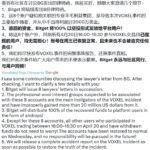In a significant development for the cryptocurrency sector, ProShares, a prominent issuer of exchange-traded funds (ETFs), announced this week that it will be launching three XRP-tracked products. This initiative appears to have been greenlit by a silent nod from the U.S. Securities and Exchange Commission (SEC), propelling the ETF issuer into the spotlight. The new offerings will include an Ultra XRP ETF with 2x leverage, a Short XRP ETF, and an Ultra Short XRP ETF with -2x leverage, as per the latest filings.
While this move indicates a growing acceptance of cryptocurrency products, ProShares is still awaiting approval for a spot XRP ETF. So far, the SEC has acknowledged multiple applications for spot XRP ETFs, including a critical application from fund manager Grayscale, which has a deadline looming on May 22. Interestingly, these advancements come on the heels of Teucrium’s recent launch of the first XRP ETF in the U.S., which debuted earlier this month and quickly amassed over $5 million in trading volume on its first day, marking it as the firm’s most successful launch to date.
Additionally, last week saw the CME Group introducing XRP futures to its platform, joining major cryptocurrencies like Bitcoin, Ethereum, and Solana in the derivatives market. This surge in XRP-related financial products stems from a pivotal victory for Ripple, the company behind XRP, in its prolonged legal battle against the SEC, which was ultimately resolved in March, lifting significant regulatory hurdles for the cryptocurrency.
As the landscape of cryptocurrency investment continues to evolve, these developments showcase the increasing legitimization of digital assets within the traditional financial systems.

ProShares to Launch XRP-Tracked ETFs Amid Regulatory Developments
The introduction of new XRP-tracked ETFs by ProShares highlights a significant development in the cryptocurrency investment landscape. Here are the key points:
- Introduction of Three XRP ETFs:
- Ultra XRP ETF (2x leverage)
- Short XRP ETF
- Ultra Short XRP ETF (-2x leverage)
- Tacit SEC Approval: ProShares launches its products following a non-explicit approval from the U.S. SEC, indicating a more favorable regulatory environment for cryptocurrency investments.
- Spot XRP ETF Approval Pending: ProShares’ application for a spot XRP ETF remains under review, with similar applications from other fund managers like Grayscale also pending.
- Recent Trading Success: Teucrium’s 2x XRP ETF became the first XRP ETF to trade in the U.S., achieving over $5 million in trading volumes on its debut, showcasing strong market interest.
- CME Group’s XRP Futures: The recent introduction of XRP futures to the CME Group emphasizes the expanding derivatives market for cryptocurrencies, culminating in broader trading options for investors.
- Ripple’s Legal Victory: The conclusion of Ripple’s court case against the SEC in March has opened up regulatory pathways for XRP, enhancing the overall market perception of the cryptocurrency.
“The flurry of ETFs tracking XRP indicates growing institutional interest and could significantly impact retail investors’ access to cryptocurrency.”
These developments around XRP ETFs can potentially transform investment strategies for retail investors by providing new ways to gain leverage and exposure to this cryptocurrency. With more products and possibly better regulatory clarity, readers could find better opportunities and diversified options in their investment portfolios.
Comparative Analysis of ProShares’ New XRP ETFs and Market Dynamics
The recent announcement by ProShares to launch three new XRP-tracked exchange-traded funds (ETFs) comes at a pivotal moment in the financial markets, especially considering the shifting landscape surrounding cryptocurrency regulations and the spotlight on XRP. While ProShares capitalizes on what appears to be tacit SEC approval for their products, the market is witnessing a competitive surge with previous entrants like Teucrium’s 2x XRP ETF making waves just weeks prior. This influx indicates a growing acceptance of cryptocurrencies in more traditional investment frameworks, but it also raises some intriguing questions about the dynamics of competition and market positioning.
Competitive Advantages: ProShares’ entrance into the XRP ETF space provides the firm with a unique positioning, as it offers not just standard exposure to XRP but also leveraged products that can attract risk-seeking investors looking to amplify gains. The Ultra XRP ETF, with its 2x leverage, caters to traders eager for high-risk, high-reward opportunities, while the Short XRP ETF allows bearish sentiment to be capitalized on in a volatile market. This diverse offering can appeal to a broad audience—from seasoned traders to novices looking to dip their toes into cryptocurrency investments.
Moreover, ProShares benefits from brand recognition and established infrastructure, presenting higher institutional credibility compared to newer entities. Combined with the momentum generated by Ripple’s recent legal victories, the timing for these product launches seems almost serendipitous. This can potentially draw in more retail investors, particularly those who are encouraged by Ripple’s victory over the SEC, leading to an increase in overall trading activity and investment into XRP-related products.
Potential Disadvantages: However, the competitive landscape does not come without its challenges. The SEC’s indecision regarding the spot XRP ETFs remains a significant hurdle for all players in this space, including ProShares. The overarching regulator’s stance could still change, impacting XYZ ETFs’ performance and investor confidence. Additionally, with Teucrium’s early entry into the market, ProShares may primarily compete for market share against a product that has already demonstrated substantial initial traction, raising the stakes for visibility and performance differentiation. If the established trading volumes of competitors surpass ProShares’ products, it may hinder their market penetration efforts.
This increasing competition could particularly benefit traders and investors seeking a versatile and active approach to cryptocurrency investments. On the flip side, investors and fund managers, already vested in competitor ETFs, might face dilemmas as they evaluate shifting funds between options or as news coverage overshadows alternative offerings. As interest swells around XRP ETFs, it could inadvertently create confusion among potential buyers, splitting attention and resources across multiple products.
In conclusion, the landscape for ProShares and its XRP ETFs is a double-edged sword. While opportunities abound for increased investment and visibility, the cloud of regulatory uncertainty and pre-existing competition could create significant challenges. Stakeholders will need to monitor market responses closely to effectively navigate this evolving terrain.

















